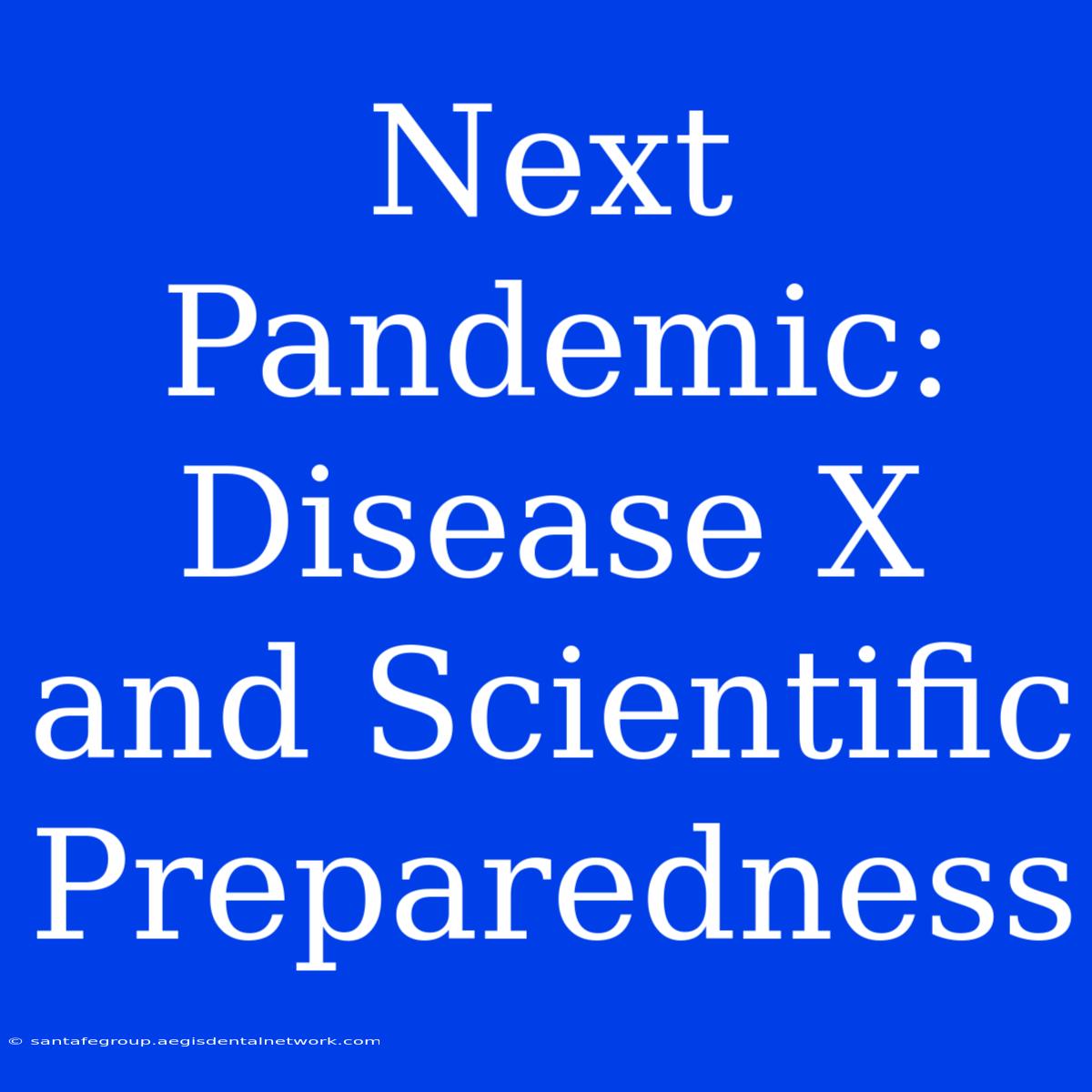Next Pandemic: Disease X and Scientific Preparedness
Is the next pandemic just around the corner? Disease X, a placeholder for a novel, unidentified pathogen, represents a stark reminder of our vulnerability to emerging infectious diseases. Understanding Disease X and bolstering scientific preparedness are critical steps towards mitigating the impact of future pandemics.
Editor Note: This article aims to explore the concept of Disease X and the urgent need for enhanced scientific preparedness to face future pandemic threats. It will discuss key aspects, such as pathogen emergence, surveillance systems, rapid diagnostics, and vaccine development.
This topic is crucial to understand as it underscores the importance of proactive measures and global collaboration in pandemic preparedness. Disease X is not a hypothetical threat; it's a stark reminder of the constant possibility of emerging infectious diseases with potentially devastating consequences.
Analysis: To provide a comprehensive understanding of Disease X, we conducted in-depth research, examining scientific publications, reports from international organizations like the World Health Organization (WHO), and expert analyses. This review offers valuable insights into the nature of Disease X, its potential impact, and the key strategies needed to mitigate its effects.
Key Takeaways:
| Aspect | Description |
|---|---|
| Pathogen Emergence | The constant emergence of new pathogens due to factors like human encroachment on wildlife habitats, climate change, and global travel. |
| Surveillance Systems | Robust surveillance networks are crucial to detect emerging pathogens and monitor disease outbreaks in real-time. |
| Rapid Diagnostics | Quick and accurate diagnostic tools are essential to identify infected individuals early, preventing further transmission. |
| Vaccine Development | Developing effective vaccines against novel pathogens requires agile research and development, including platform technologies for rapid vaccine production. |
Disease X: A Potential Threat
Introduction: Disease X represents the unknown, highlighting our vulnerability to unforeseen outbreaks. Understanding this concept is crucial for pandemic preparedness.
Key Aspects:
- Pathogen Origin: New pathogens can emerge from animal populations, like zoonotic diseases, or through mutations of existing viruses.
- Transmission: Disease X could spread through various pathways, including respiratory droplets, contact with contaminated surfaces, or vectors like mosquitos.
- Impact: The potential impact of Disease X depends on its virulence, mode of transmission, and the global response.
Discussion:
- Pathogen Origin: The emergence of pathogens like SARS-CoV-2, Ebola, and Zika virus highlights the constant threat of new infectious agents. Zoonotic diseases, where pathogens jump from animals to humans, are a major concern.
- Transmission: The speed and ease of global travel contribute to the rapid spread of infectious diseases. Understanding potential transmission pathways is critical for effective containment measures.
- Impact: The pandemic's impact on health systems, economies, and societies underscores the importance of proactive pandemic preparedness.
Scientific Preparedness: A Crucial Response
Introduction: Building robust scientific preparedness is vital to mitigating the impact of Disease X and future pandemics.
Key Aspects:
- Surveillance Systems: Early detection is critical for controlling outbreaks. This necessitates strong surveillance networks and rapid reporting mechanisms.
- Rapid Diagnostics: Fast and accurate diagnostic tools are needed to identify infected individuals quickly, enabling swift isolation and treatment.
- Vaccine Development: Developing vaccines against unknown pathogens requires advanced technologies and a collaborative global effort.
- Antiviral Treatments: Developing effective antiviral treatments for potential pandemic threats is a vital component of preparedness.
Discussion:
- Surveillance Systems: Global collaboration in surveillance is essential. Real-time data sharing and rapid response mechanisms are crucial.
- Rapid Diagnostics: Developing point-of-care diagnostics and platforms for rapid pathogen identification are critical.
- Vaccine Development: Advancements in vaccine technology, like mRNA vaccines, offer promise for rapid development of vaccines for emerging pathogens.
- Antiviral Treatments: Research into broad-spectrum antiviral treatments that can target a range of viruses is essential.
FAQ
Introduction: Here are some frequently asked questions about Disease X and scientific preparedness:
Questions:
- What is Disease X? Disease X is a placeholder term used by the World Health Organization (WHO) to represent an unknown pathogen that could cause a future pandemic.
- How likely is a future pandemic? The emergence of new infectious diseases is a constant threat. The likelihood of a future pandemic is high, highlighting the importance of preparedness.
- What can be done to prepare for a future pandemic? Strengthening surveillance systems, developing rapid diagnostics, and investing in vaccine and antiviral research are essential.
- What role does global collaboration play in pandemic preparedness? International cooperation in research, data sharing, and resource allocation is vital.
- How can individuals contribute to pandemic preparedness? Practicing good hygiene, getting vaccinated, and staying informed are crucial steps.
- What are the ethical considerations in pandemic preparedness? Balancing public health needs with individual rights and ensuring equitable access to resources are important ethical considerations.
Summary: Understanding Disease X and building scientific preparedness are crucial for mitigating the impact of future pandemics. This requires a multifaceted approach, encompassing robust surveillance systems, rapid diagnostics, vaccine and antiviral development, and global collaboration.
Closing Message: Disease X serves as a reminder of the ever-present risk of emerging infectious diseases. Proactive measures, scientific innovation, and international cooperation are essential to ensure our collective resilience against future pandemic threats.

